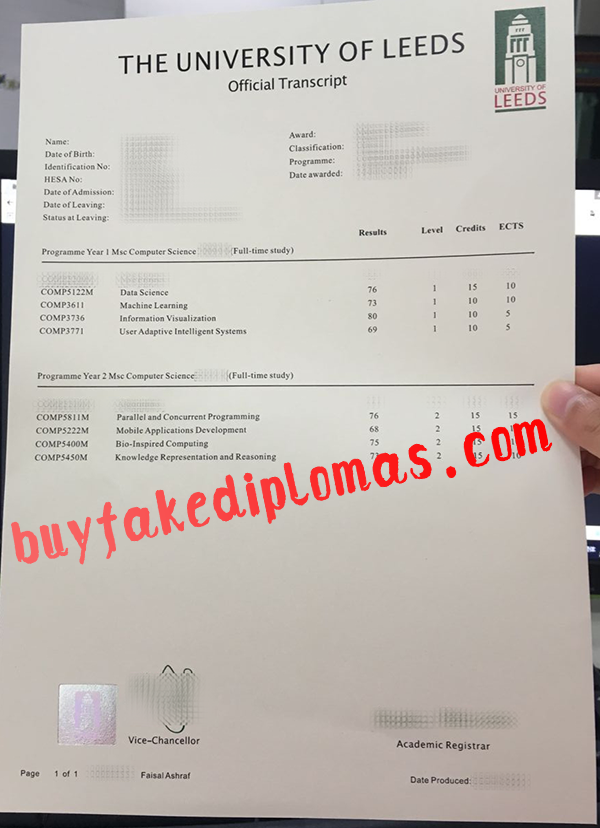We provide the best service at the most favorable price in the market. The original stamps / stickers, perfect and authentic seal and badge samples help you obtain the ideal certificate add our whatsapp: +86 15179517591
How Much Does A Fake University of Leeds Transcript Cost?

University of Leeds Transcript
The history of the University of Leeds is linked to the development of Leeds as an international centre of the British textile industry and garment manufacturing during the Victorian era. The origins of the university can be traced back to the establishment of medical schools for the general public in English cities. Before 1900, buy fake University of Leeds diploma, only six universities had been established in England and Wales: Oxford (founded between 1096 and 1201), Cambridge (c. 1201), London (1836), Durham (1837), Victoria (1880) and Wales (1893). Victoria University was founded in Manchester in 1880 by Royal Charter as the Commonwealth University of the North of England. buy fake University of Leeds Transcript, buy fake University of Leeds degree, Owens College was the only college at the University of Victoria between 1880 and 1884; In 1884, the University College of Liverpool joined; In 1887, Yorkshire College became the third college to join the University. On 6 June 1831, six physicians and surgeons established the Leeds Medical School. buy fake University of Leeds certificate. Its purpose was to establish a medical school in Leeds to offer lectures on subjects relating to medicine and surgery in order to qualify for examinations in the College of Surgeons and Pharmacists. The medical school enrolled its first students in October of that year. It was one of ten provincial medical colleges established during the decade of 1824 to 1834. How Much Does A Fake University of Leeds Transcript Cost?
In 1851, the College of Science, modeled on Owens College in Manchester, was founded, as the universities of Oxford, Cambridge and London allowed only members of the Church to attend. As a non-fundamentalist teaching institution, it is open to Protestant dissidents, Catholics and Jews (though not to women). Although faith requirements were abolished at University College London in 1850, Oxford and Cambridge continued a classic-based education. The University of the North continues to offer a progressive and practical general education, just like the German technical institutes and the classical universities on which they were modeled.
In 1874, the Yorkshire College of Science was formally established to educate middle-class merchants and the children of merchants. The Yorkshire Academy began by teaching experimental physics, mathematics, geology, mining, chemistry and biology, and soon became known as an international centre for engineering and textile technology research (due to West Yorkshire’s monopoly in manufacturing and international trade in textiles). A few years later, when the college began offering courses in classic and modern literature and history, Yorkshire Science College became Yorkshire College.
In 1884 Yorkshire College absorbed the Leeds Medical School and on 3 November 1887 joined the Commonwealth University of Victoria (founded in Manchester in 1880), before which the University of London was responsible for the awarding of external degrees.
Leeds got its first university when Yorkshire College joined the Federal University of Victoria on 3 November. Unlike Owens College, UVIC’s Leeds campus has never banned women from its classes. However, it was not until 1896, when special facilities were provided at day training colleges, that women began to enroll in large numbers. The first female student to take a course at the university was Lilias Anne Clark, who studied modern literature and pedagogy.
The University of Victoria (Leeds) was a short-lived concept, as member colleges from Manchester and Liverpool were keen to establish themselves as independent universities. This was partly because of the benefits to the cities of Liverpool and Manchester of having a university, and also because institutions were not satisfied with the practical difficulties of maintaining distant federal arrangements. In 1900, after lobbying by Joseph Chamberlain, the University of Birmingham was granted a royal charter, further stimulating the interest of individual cities in establishing independent universities.
Following the enactment of a Royal Charter and an Act of Parliament in 1903, the then newly formed University of Liverpool became the first member to gain independence, beginning to split the University of Victoria. The University of Leeds followed suit and was granted an independent Royal Charter by King Edward VII in 1904.
